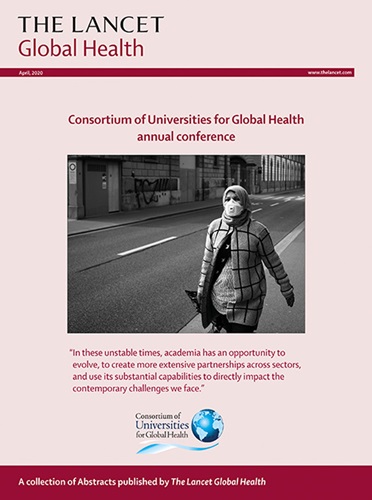Screening for asymptomatic tuberculosis among adults with household exposure to pulmonary tuberculosis: a prospective observational cohort study.
IF 19.9
1区 医学
Q1 PUBLIC, ENVIRONMENTAL & OCCUPATIONAL HEALTH
引用次数: 0
Abstract
BACKGROUND More than half of tuberculosis cases detected by community prevalence surveys are classified as asymptomatic. We evaluated yield of symptom and chest radiograph screening of tuberculosis-exposed household contacts in South Africa. METHODS For this prospective observational cohort study, adult volunteers (aged ≥18 years) with household exposure within the past 6 months to patients with untreated or partially treated pulmonary tuberculosis, identified through local health services, were enrolled at three sites in South Africa (Worcester and Ravensmead, Western Cape Province, and Soweto, Gauteng Province). Household contacts were excluded if they were unlikely to attend study visits, or had conditions interfering with consent or study participation, including psychiatric illness, substance dependence, or incarceration. Systematic screening of tuberculosis symptoms (any duration), chest radiograph (any abnormality indicative of active tuberculosis), and sputum microscopy, Xpert Ultra, and liquid culture were performed. Serum C-reactive protein (CRP) was measured by multiplex bead array. Prevalent tuberculosis was microbiologically confirmed (Xpert Ultra or culture). Symptomatic and asymptomatic tuberculosis were defined as prevalent tuberculosis with and without reported symptoms compatible with tuberculosis. The primary outcome was the diagnostic yield (sensitivity) of microbiologically confirmed pulmonary tuberculosis. FINDINGS Between April 22, 2021 and Sept 22, 2022, 979 household contacts were enrolled, 345 (35·2%) male and 634 (64·8%) female, 185 (18·9%) living with HIV and 187 (19·1%) with previous tuberculosis. Prevalent tuberculosis occurred in 51 (5·2%) and was asymptomatic in 42 (82·4%) of 51. Only 13 (31·0%) of 42 asymptomatic people with tuberculosis were sputum-smear positive; eight (61·5%) of these 13 had a low bacillary burden, with smear grades scanty or 1+ (1-99 acid-fast bacilli per 100 fields). CRP did not discriminate healthy household contacts from those with asymptomatic tuberculosis (area under the curve 0·60, 95% CI 0·47-0·73). An abnormal chest radiograph suggestive of tuberculosis was observed in 23 of 41 asymptomatic (sensitivity 56·1%, 95% CI 41·0-70·1) versus eight of nine symptomatic (sensitivity 88·9%, 56·5-98·0) people with tuberculosis. Sensitivity of chest radiograph in combination with symptom screening was 32 (64·0%) of 50 (50·1-75·9) for all prevalent tuberculosis. INTERPRETATION More than 80% of confirmed people with tuberculosis among household contacts were asymptomatic; chest radiograph screening missed more than 40% of these. Community prevalence surveys reliant on symptom-based and chest radiograph-based approaches might substantially underestimate the prevalence of asymptomatic tuberculosis in endemic countries. FUNDING Regional Prospective Observational Research for Tuberculosis South Africa through funding from the US National Institutes of Health, the Civilian Research and Development Foundation, and the South African Medical Research Council.在家庭暴露于肺结核的成年人中筛查无症状肺结核:一项前瞻性观察队列研究
背景:社区流行病学调查发现的一半以上的结核病病例被归类为无症状。我们评估了南非肺结核家庭接触者的症状和胸片筛查率。方法:在这项前瞻性观察队列研究中,在南非的三个地点(西开普省的伍斯特和拉文斯米德,豪登省的索韦托)招募了通过当地卫生服务确定的在过去6个月内家庭暴露于未经治疗或部分治疗的肺结核患者的成年志愿者(年龄≥18岁)。排除家庭接触者,如果他们不太可能参加研究访问,或者有妨碍同意或参与研究的情况,包括精神疾病、物质依赖或监禁。系统筛查结核症状(任何持续时间)、胸片(任何表明活动性结核的异常)、痰液镜检、Xpert Ultra和液体培养。采用多重头阵列法测定血清c反应蛋白(CRP)水平。微生物学证实流行肺结核(Xpert Ultra或培养)。有症状和无症状结核病被定义为有和没有报告的与结核病相一致的症状的流行结核病。主要终点是微生物学确诊肺结核的诊断率(敏感性)。结果:在2021年4月22日至2022年9月22日期间,纳入了979名家庭接触者,其中345名(35.2%)男性,634名(64.8%)女性,185名(18.9%)感染艾滋病毒,187名(19.1%)患有既往结核病。51例(5.2%)发生流行结核,42例(84.2%)无症状。42例无症状肺结核患者中,痰涂片阳性13例(31.0%);其中8个(61.5%)的细菌负荷较低,涂片等级为1+或很少(每100个田1-99个抗酸杆菌)。CRP不能区分健康的家庭接触者和无症状肺结核患者(曲线下面积0.60,95% CI 0.47 - 0.73)。41例无症状者中有23例(敏感性56.1%,95% CI 41.0 ~ 70.1)胸片异常提示结核,而9例有症状者中有8例(敏感性88.9%,56.5 ~ 98.0)提示结核。胸片结合症状筛查对所有流行结核病的敏感性为32(64.0%)/ 50(50.1 - 75.9%)。解释:在家庭接触者中,超过80%的确诊结核病患者无症状;胸片筛查漏诊超过40%。基于症状和胸片的社区患病率调查可能大大低估了无症状结核病在流行国家的患病率。资助:通过美国国立卫生研究院、民间研究与发展基金会和南非医学研究理事会的资助,开展南非结核病区域前瞻性观察研究。
本文章由计算机程序翻译,如有差异,请以英文原文为准。
求助全文
约1分钟内获得全文
求助全文
来源期刊

Lancet Global Health
PUBLIC, ENVIRONMENTAL & OCCUPATIONAL HEALTH-
CiteScore
44.10
自引率
1.20%
发文量
763
审稿时长
10 weeks
期刊介绍:
The Lancet Global Health is an online publication that releases monthly open access (subscription-free) issues.Each issue includes original research, commentary, and correspondence.In addition to this, the publication also provides regular blog posts.
The main focus of The Lancet Global Health is on disadvantaged populations, which can include both entire economic regions and marginalized groups within prosperous nations.The publication prefers to cover topics related to reproductive, maternal, neonatal, child, and adolescent health; infectious diseases (including neglected tropical diseases); non-communicable diseases; mental health; the global health workforce; health systems; surgery; and health policy.
 求助内容:
求助内容: 应助结果提醒方式:
应助结果提醒方式:


